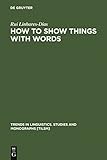How to Show Things with Words : A Study on Logic, Language and Literature / Rui Linhares-Dias.
Material type: TextSeries: Trends in Linguistics. Studies and Monographs [TiLSM] ; 155Publisher: Berlin ; Boston : De Gruyter Mouton, [2011]Copyright date: ©2006Description: 1 online resource (544 p.)Content type:
TextSeries: Trends in Linguistics. Studies and Monographs [TiLSM] ; 155Publisher: Berlin ; Boston : De Gruyter Mouton, [2011]Copyright date: ©2006Description: 1 online resource (544 p.)Content type: - 9783110179958
- 9783110899627
- 401 22
- P107 .L56 2006
- online - DeGruyter
- Issued also in print.
| Item type | Current library | Call number | URL | Status | Notes | Barcode | |
|---|---|---|---|---|---|---|---|
 eBook
eBook
|
Biblioteca "Angelicum" Pont. Univ. S.Tommaso d'Aquino Nuvola online | online - DeGruyter (Browse shelf(Opens below)) | Online access | Not for loan (Accesso limitato) | Accesso per gli utenti autorizzati / Access for authorized users | (dgr)9783110899627 |
Browsing Biblioteca "Angelicum" Pont. Univ. S.Tommaso d'Aquino shelves, Shelving location: Nuvola online Close shelf browser (Hides shelf browser)

|

|

|

|

|

|

|
||
| online - DeGruyter Aktiengesetz : Großkommentar. Band 2, §§ 148–178 / | online - DeGruyter Das Tschechoslowakische Strafgesetzbuch vom 12. Juli 1950 : (in der Fassung vom 22. Dezember 1956). | online - DeGruyter Die Ungarische Strafprozeßordnung : III. Gesetz vom Jahre 1951 durch Gesetz V vom Jahre 1954 modifizierter Text / | online - DeGruyter How to Show Things with Words : A Study on Logic, Language and Literature / | online - DeGruyter Norwegian Modals / | online - DeGruyter King Manasseh and Child Sacrifice : Biblical Distortions of Historical Realities / | online - DeGruyter Schleiermacher and Whitehead : Open Systems in Dialogue / |
I-XXII -- Introduction -- Part 1: Prolegomena -- 1. The linguistic structure of narrative transmission -- 2. Linguistics in narratology: A critical historical survey -- 3. The narrating stance as locutionary subjectivity -- Part 2: The temporal-perspectival organization of discourse -- 4. Tense -- 5. Aspect -- 6. Aktionsart -- 7. The effects of Aktionsart on narrative transmission. 7.1. Introduction -- 7. The effects of Aktionsart on narrative transmission. 7.2. -STAT eventuality descriptions -- 7. The effects of Aktionsart on narrative transmission. 7.3. +STAT eventuality descriptions -- 7. The effects of Aktionsart on narrative transmission. 7.4. World-knowledge based event semantics -- 7. The effects of Aktionsart on narrative transmission. 7.5. Concluding remarks -- Conclusion -- Appendix 1 -- Appendix 2 -- Notes -- References -- Index of names -- Index of subjects
restricted access online access with authorization star
http://purl.org/coar/access_right/c_16ec
How to Show Things with Words is an interdisciplinary research study at the interface between linguistics and philosophy which sheds new light on the narrative-theoretical issue of proximal vs. distal stance adoption in discourse. Narrative distance ultimately depends on the epistemological source of the information conveyed, but English and other Indo-European languages have no inflectional systems for (en)coding that source of knowledge. To fill in the gap, speech act theory is (re)considered in the light of philosophical research on linguistic functions and a parallel is drawn between grammaticalized evidential categories and the objectifying acts of Husserl's phenomenology of constitution. These intuitive vs. signitive intentional acts do, indeed, roughly correspond to direct vs. indirect evidentiary forms and can be inferred from the temporal-perspectival organization of discourse by the so-called intimation or announcement function of language-systems. It turns out that perspectival immediacy requires tenses with overlapping event- and reference-points, but predictions of the sort are non-monotonic forms of reasoning defeasible by quantificational aspect distinctions, on the one hand, and inherent meaning considerations, on the other. To substantiate this claim, the bulk of the book provides an in-depth formal semantic account of tense, aspect and Aktionsart, interwoven with a detailed analysis of the cognitive processes associated with eventuality-description types. The book adresses an audience of linguists in general, formal semanticists, cognitive scientists, philosophers and narratologists with an interest in natural language semantics.
Issued also in print.
Mode of access: Internet via World Wide Web.
In English.
Description based on online resource; title from PDF title page (publisher's Web site, viewed 28. Feb 2023)


